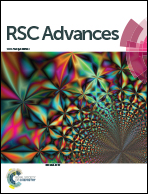Synthesis of meso-(4′-cyanophenyl) porphyrins: efficient photocytotoxicity against A549 cancer cells and their DNA interactions†
Abstract
We report a facile iodine(III)-mediated synthesis of cyanoporphyrins and their DNA photocleavage activity. Cationic-porphyrin 9a showed intercalative binding towards DNA, whereas Zn(II)-cyanoporphyrinate 9b showed outside electrostatic binding as indicated by their absorption and emission spectra. Porphyrin 9a displayed significant photocytotoxicity against A549 cancer cell line with an IC50 value of 54 nM.


 Please wait while we load your content...
Please wait while we load your content...